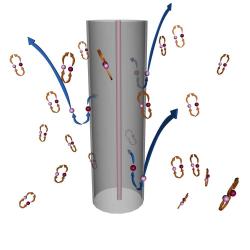| The Moon glows red among the background stars of Leo the Lion during the February 20/21 total lunar eclipse. The bright planet Saturn also lies nearby. Astronomy: Roen Kelly [View Larger Image] The last total lunar eclipse until December 20, 2010, will thrill observers throughout North America February 20. "This eclipse is perfect for getting the family together," Astronomy Senior Editor Michael Bakich says, "because it begins early in the evening." On February 20, eclipse observers should plan to get out lawn chairs, binoculars, and low-power eyepieces. And, this year, better add a blanket. A lunar eclipse occurs when the Moon, in orbit around Earth, passes into Earth's shadow. Because the Sun isn't a point of light, the shadow has two parts — the inner, darker umbra and the outer, lighter penumbra. If the whole Moon enters the umbra, the eclipse is total. If the umbra hides only part of the Moon, the eclipse is partial. The eclipse's umbral phase begins at 8:43 P.M. EST. On the East Coast, the Moon already stands one-third of the way up in the eastern sky. For West Coast observers, the Moon rises minutes after the umbra touches its surface. Earth's shadow takes 78 minutes to envelop the Moon. Totality (when the Moon lies completely within Earth's umbra) begins at 10:01 P.M. EST. The Moon won't disappear, however. Some sunlight passing through Earth's atmosphere falls on the lunar surface. The cleaner our atmosphere is, the lighter the eclipse will be. Dark eclipses generally occur after large volcanic eruptions. |
| August's lunar eclipse, seen here, put on a nice show from western North America. This month's total eclipse, in contrast, favors the whole continent. Stephen James O'Meara [View Larger Image] During totality, the Moon's northern edge will appear darker than its southern side. This disparity occurs because the Moon's northern limb will lie closer to the center of Earth's shadow. Totality lasts 51 minutes. During the first half, as the sky becomes progressively darker, the background stars of Leo the Lion will appear. The constellation's brightest star, Regulus, appears 3° (6 Moon-widths) above the Moon. You also will spot Saturn easily 4° (8 Moon-widths) to the Moon's lower left. The eclipse is a great time to notice how the Moon moves through the sky. As the eclipse begins, the Moon lies 4.4° from Saturn. When the event ends, the gap measures only 3.5°. After totality, it takes the Moon another 78 minutes to leave Earth's umbra. |
























.jpg&w=250)
